#Chinese Theatres
Explore tagged Tumblr posts
Text
Once the theatre monkey discovers angsty broadway musicals its all over y'all
or: I got a new personal project I'm workin' on! I'm at the first pass on the animatic rn! I forgot that 'generate matte' is a thing you can do in SB Pro for a whole hour!! I'm suffering!!!
#lmk#lego monkie kid#animatic#wip#storyboarding#fanart#six eared macaque#liu'er mihou#lmk macaque#shadowpeach#sun wukong is not here but he is haunting the mini-narrative#mac thinks HE's doing the haunting lol nah dude your ex-mans is living rent-free in ur cranium#I heard this song in a 'cartoon villain playlist' and only learned later it was from a play and went like:#“and i can feel bitter shadowpeach feels in this chilis tonight”#something something Denial something something river in Egypt#this is what happens when u don't talk about your feelings#POV: you're on the downward spiral but you're taking it like a waterslide#for real my favorite part of mac's character arc is where he's justifiably Bitter About It#but that won't stop him from being UNjustifiably a huge piece of work and Extremely Biased about it#it being the past events where two monkies both managed to fumble the bag in adjacent but slightly different ways#macaque ilu but u are not genre-savvy sometimes#i know mac is a chinese character BUT#he would totally spell theatre <- this way if he learned to read/write in english#i actually headcanon that his magical celestial monkey hearing would make it REALLY easy to pick up new languages but not the writing#oop i forgot: song is For The Record from 36 Questions#which I have not seen so idk how thematically relevant the og song context will be here
276 notes
·
View notes
Text
If you were watching Nosferatu and you noticed the doctors talking about how Ellen had too much blood and that's why she was acting crazy - let me explain why (and also how excited I am that it was included in the script).
From ancient Greece through the Renaissance, we believed in The Four Humors in medicine. Essentially, they thought there were four fluids in the body (blood, yellow bile, black bile, and phlegm) and they determined a person's temperament; an imbalance of them was believed causes illness. The Four Temperaments (based on the balance of their humors) are as follows:
Sanguine: Optimistic and social - (affected by blood)
Choleric: Short-tempered and irritable - (affected by yellow bile)
Melancholic: Analytical and quiet - (affected by black bile)
Phlegmatic: Relaxed and peaceful - (affected by phlegm)
They were also connected to celestial bodies, seasons, body parts, and stages of life. Here's a neat little chart:
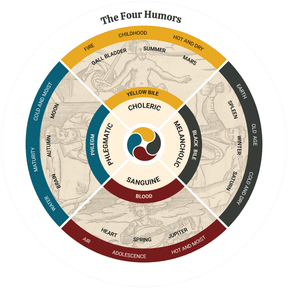
Ellen was already rather macabre, and as she spiraled she became less able to adhere to social convention; it makes sense that a doctor of the time would consider that to be an imbalance of her blood. It also feels worth stating that a sanguine temperament can be likened to the manic phase of a bipolar episode, which Ellen's symptoms certainly could have been indicative of.
I also think it's an interesting (though possibly pointless) connection that a sanguine temperament is linked to the heart, to adolescence, and to Spring.
The heart obviously links to Ellen as she's a hopeless romantic. Adolescence also connects due to not only her young age in the film, but the events causing Orlok's fascination with her happened when she was quite young as well. I would argue that you can tie Spring into Ellen's character also - she was blooming, transforming, awaiting a new breath of life (death?).
It made me so happy to see it included so casually, it was such an accurate portrayal of how medicine would have actually been practiced at the time and it wasn't made into a huge thing. It shows the appreciation and effort Eggers brings to his work.
I can absolutely see how you may just brush past that part (it was brief), or attribute it to vampirism, but it's actually a super cool little detail of our real life medical history!
#I got so excited in the theatre my sister was like wtf is wrong with you (when i explained later she was like oh wait that is cool lol)#im not a doctor and never took any classes in medicine.. just a nerd if im wrong about smth pls let me know#it reminds me of how trad chinese medicine balances the body but obv different#when i worked in TCM (not as a practitioner) i was like wait we're basing diagnoses off of hot and moist this is like Galen lol#ive not seen anyone else mention this and it adds some realism to the story#nosferatu#count orlok#ellen hutter#robert eggers#film analysis#film#horror films#gothic horror#medical history#fun facts#media analysis#my post
148 notes
·
View notes
Text

Promotional Ticket Booth For King Kong
Grauman's Chinese Theatre (1933)
#Film#King Kong#Grauman's Chinese Theatre#Photography#Gorillas#Vintage#Art#Horror#Horror Films#Horror Movies#1933#1930s#30s
345 notes
·
View notes
Text




I think I posted this before, but that was no doubt 4,000 posts ago. So here you go again.
It might be hard to believe but the car used at the beginning of 'The Pink Panther Show' cartoon series was actually the real thing. If you cast your mind back, the sequence involved the car pulling up at Grauman's Chinese Theatre in and the film then cuts to the animated scenes.
The car was built in 1969 and was based on an Oldsmobile Toronado complete with 7 litre engine. It was pink of course with pink furry interior which also contained a bar and a mobile phone.
I'm pretty certain the Pink Panther wasn't real though. Award yourself 5 bonus points if you can still hum the theme tune.
#oldsmobile toronado#oldsmobile#Toronado#car#cars#pink panther#the pink panther#Grauman's Chinese Theatre#hollywood
158 notes
·
View notes
Text


Sidney Poitier immortalizing his hand and footprints at Grauman’s Chinese Theatre in 1967.
74 notes
·
View notes
Text




Nuo theatre 傩戏 masks from Guizhou province, China. 🎭🎨
(Not to be confused with “Noh theatre” from Japan, which traces its origin to the Chinese Nuo)


#china#🇨🇳#Chinese culture#nuo theatre#masks#theater masks#theatre#Chinese heritage#Guizhou#nuo#Chinese opera#chinese folklore#🎭#crafts#Chinese crafts#east Asia#prc#people’s republic of china#noh#noh theatre#Japanese noh#Noh theater#Nuo theater#theater
41 notes
·
View notes
Text

#nsync#trolls#brozone#trolls band together#dream works#animation movies#premiere#trolls movie#november#2023#jc chasez#chris kirkpatrick#joey fatone#lance bass#justin timberlake#*nsync#tcl chinese theatre#los angeles#california#hollywood#jtimberlake#jt#timberlake
301 notes
·
View notes
Text
Triple Date: Hualian, Fengqing and Quanyin.
They attend a Chinese Opera.
XL and MQ are watching enraptured, completely obsessed with the story being told, the music, the performance, all of it!
HC hasn't noticed the performance at all, he's watching XL's face.
FX doesn't really care that much. Also:
FX: *sees some impressive acrobatics* "I could do that"
XL, MQ and HC, in unison: "no you couldn't"
QYZ keeps trying to run off because he's bored. YY likes Opera but he is too focused on keeping QYZ in his seat. He misses most of the performance (XL later buys him a solo ticket, with HC's money obviously, so he can see one on his own). QYZ eventually settles down when YY holds his hand. QYZ, despite his boredom, is happy to be out in public with Shixiong!
#tgcf#tian guan ci fu#heaven official's blessing#hualian#fengqing#quanyin#hua cheng#xie lian#feng xin#mu qing#quan yizhen#yin yu#idk what traditional Chinese theatre culture is like#like is it traditional to eat snacks or whatever?#if it is#hc absolutely sends YY and QYZ to get food#QYZ insists on paying for Shixiong#YY is having a hard time but at least he's enjoying the music#XL and FX used to attend the theatre all the time back in Xianle#XL has always loved it#FX just accepts it
128 notes
·
View notes
Text
Riverside Code at Qingming Festival (清明上河图密码) : Nightlife at Bianjing City
youtube
Fireworks

Firework-driven Puppetry
Once thought to be a lost art and rediscovered in the 1990s, this is a special form of puppetry that has a 13-15 meters tall bamboo "tree" with tiers to which wheels of gunpowder and puppets are attached, so when the fuse is lit, the puppets start moving around along with the spiralling fireworks.

Molten Iron Flowers
Originating in the Northern Song Dynasty, Henan province, datiehua the craft of striking liquid iron with sticks to create showers of sparks.

.
Peddlers
The character design was designed based on "Picture of a Peddler" by Li Song, a painter from the Song Dynasty.
This is a round fan painting on silk with light ink and color, now in the collection of the Palace Museum in Beijing. The whole picture depicts an old peddler carrying a load of goods on his shoulders approaching the village, with many women and children competing to by the goods.. Depicting the life of the working people as an aesthetic object is a common practice in ancient Chinese art.

.
Roadside Stalls and Lanterns
Small taverns that have official alcohol selling license and retail to diners and wholesale to major restaurants or simply earn money as foot shops.

Rolling lantern dance
Folk dance that originated from Zhejiang Province, it has been passed down from generation to generation and is a competitive dance performed every year.



Flying Star Lantern
Due to its elaborate design, it's used especially in the palace banquets and temple fairs during the Lantern Festival.

Horse Riding Street Lanterns
Social public welfare lighting kicked off the most in Song dynasty. There were street lights installed by temple gates, by bridges and by waterbodies.

Seven-Star Lotus Lantern
Used by nobility, representing hopes for longevity.
.
Gōulán wǎ shě - Fixed Entertainment Venues


Equivalent to modern day amusement parks, there were many of these situated at the corners of Song Dynasty capitals, open all around the year and especially bustling with people during the holidays. These places had all sorts of entertainment in one place, and the show featured some as below:
Skeleton Fantasy Show
A nursing mother sitting next to a skeleton puppeteer with a skeleton puppet, again based on a famous painting by Li Song, it's been lost to time what exactly does this macabre but wholesome picture depicts, the drama interprets it as some kind of Song Dynasty folktale stage performance.


Quack Eyedrop Seller
In the Northern Song Dynasty, goods were prosperous and there were many profiteers, which lead to street-skits being made to parody/mock the rampant fake merchants and warn the people of counterfeit goods. These skits were very popular and became the subject of paintings. There are two paintings by unnamed Song Dynasty artists in Beijing Palace Museum, showcasing a skit about a quack eyedrop seller. The guy wearing red is the "doctor", with numerous little bottles with eyes painted on them.


Women's Wrestling
OK now this is the COOLEST discovery in this entire post, and one thing that the show failed to properly represent, for reasons you'll understand in a second. Did you know that in Song dynasty women were allowed to do sumo half naked in public??? Because the shirtlessness and skin-to-skin contact is an important feature in sumo, it's said that the emperor allowed women to do the same and that he himself enjoyed women's sumo performances too! And in the Royal Palace, even concubines particioated in sumo competitions with each other! And obviously in modern day women are back to covering up which is such a shame. The dramas only shows two little girls wrestling and they are all covered up too which is understandable, I'm thankful that they included this feature so I could at least look it up and find all this delightful information.

Chinese Circus
Aerial acrobatics at the Entrance, Using feet to manipulate objects, Stilt-Walking
Intangible cultural heritages, click the link to read in depth.




[In stilt performances, Usually there are two forms: "Wen Xiao" and "Wu Xiao". Wu Xiao emphasizes tricks, Wen Xiao focuses on theatrics and making jokes]
Puyang Daxian "Shirtless" Opera, Mulian "Ghost" Opera


Shadow Puppetry, Bloody Shehuo



[Bloody Shehuo is the most gruesome among Shehuo performances, which are supposed to represent punishing evil and bringing good fortune to the new year.]
.
youtube
.
Riverside Code at Qingming Festival ( 清明上河图密码 ) : Qīngmíng shànghé tú mìmǎ Cultural Meta Masterpost
#Riverside Code at Qingming Festival#chinese history#cdrama#chinese drama#chinese theatre#清明上河图密码#Youtube#chinese fireworks#chinese lanterns#chinese puppetry#chinese opera#women's wrestling
31 notes
·
View notes
Text
Happy New Year!! Big Bulk Release~!!
Credits for the video -> https://x.com/yuzurinwx/status/1874109052869107827

Credit for the image -> https://x.com/wangxiangallery/status/1874124692346527896
Wish you all a Very Happy, Prosperous and Healthy New Year 2025!!




And for the first day of 2025, we have a bulk release of lots of goodies (7 AD episodes + 1 novel chapter)~
1) Global Examination AD S1 Ep 16, 17 + 3 Extras <=== This completes S1 (the older version) of the audio drama! 🥳🥳🥳
2) Kaleidoscope of Death AD S1 Ep 6
3) Tian Ya Ke (Faraway Wanderers) AD S1 Ep 3
4) The Fantastical Beasts At World's End Chapter 33
All of the episodes can be accessed via our discord server. To request an invite to the server, please fill up this >> request form<<
>> Link to Chapter 33 of the novel (viewable and downloadable) <<
!!!!Please note:!!!!! The cover for this novel that we shared in our previous announcement of chapters 24 and 25 is a fan-made cover. Please do not submit it anywhere (on sites like novelupdates). Since it is a fan-made cover by our team member, we just wanted to share it with everyone who follows us. Please do not share it or upload it on any novel reading websites.
Please also note: In case you try to open above link or any links from us on your phone and get an error message, please just try opening the link in your phone’s internet browser, go to the address bar and remove the “href.li” part and proceed to open the link.
*********
If you like The Fantastical Beasts at World's End novel story, then please consider supporting the author by directly purchasing the novel from jjwxc >> Here
A guide on how to purchase from jjwxc is linked at the top on >> this page
*********
Our ongoing projects: >> Link
Our revamped Carrd: >> Link
*********
Notes:
1) Please use >> VLC Player << to play the file. It is available for a large range of operating systems as well as devices.
For advanced users, I’d recommend >> K-lite codec pack + MPC-HC player << Standard version or above. The player is included from the standard version onwards.
2) Please avoid sharing these files on YouTube and other video streaming platforms. If you wish to share our subbed files, please just reblog or link this tumblr post.
3) Copper Coins, Global Examination, Panguan, Qianqiu, Mou Mou, Mo Dao Zu Shi, Kaleidoscope of Death and Tian Ya Ke Audio Dramas are paid dramas. So please consider purchasing these audio drama if possible in order to support the original content creators. Links to the original CN audio only ADs have been linked in the >> projects << page for ease of navigation.
Happy watching~! 💖
#global examination#qqgk#tian ya ke#faraway wanderers#tyk#kaleidoscope of death#kod#audio drama season 1 episode 16#episode 17#minitheatre#mini-theatre#episode 3#episode 6#english subbed#fan subbed#english translation#fan translation#the fantastical beasts at world's end#novel#chinese danmei novel#末世之凶���#chapter 33#pure love#drama#action#historical#fantasy#mu su li#priest#treasure chest subs
25 notes
·
View notes
Text


Domhnall Gleeson at 'The Revenant' World Premiere in Hollywood, CA
📸 Sthanlee B. Mirador (16.12.2015)
40 notes
·
View notes
Note
Hello! Sorry to bother you.
I noticed you are in JTTW fandom and wanted to ask if you know where can I find more info on Sun Wukong's make up and stage performance? I tried to find stuff on my own but quickly realised that I'm just one small weak goblin. I saw some blogs about chinese opera behind the scenes with SW images and couple of videos but that's about it... and since you look like you are way more knowledgeable I came here to beg a favour.
Do you know any videos, documentaries or blogs on this topic?
Thank you for your time ♥♥♥
Hi!
TLDR: Bold text are writings/videos linked to Peking Opera Culture and specifics surrounding Monkey King performances. Post has a mid-length summary of key aspects of his Peking appearances and core thematics. This mainly goes along visual design analysis, as I don’t focus in performance art as much! Read more divide for courtesy
(Also taking a moment to highly praise @/bonesmarinated ‘s Peking opera Wukong pieces!)
The Monkey King/Sun Wukong is a very well covered and well performed character in Peking Opera, I’ll give a short(ish) summary of the key aspect of his design across various performances based on work I can recall from my Undergrad as well as my own experience- and i’ll link any documents/websites/images I have on hand
Wukong’s Lian Pu falls under what is known the Jing role (complex hero) with similar facial decoration also being delegated to the Chou roles in Opera as well.
The dominant school of art in depicting him either on live performers or maskwear, have a fairly universal foundation for his appearance.

The oldest forms of Peking opera stick to Wuseguan (Five Colour Theory) with his Lian Pu sticking to a core 3 of White (Cunning), Red (Bravery), and Black (Loyalty). Even with Modernisation of the Peking Opera and developments in the science behind art and makeup, Lianpu is specific in its purpose of portraying the nature of a character beyond body language and aiding in accessibility for people at the far end of the audience.
The Monkey King’s Lian Pu is reflective of his mischievous and bold nature, combining it with the shape of an Old World Monkey’s furless face shape so that even those “uneducated” in Peking Opera culture can at least see /what/ Wukong is before they see /who/ he is. The White and red placement are linked to yin-yang dynamics relating to the stone he was born from and the energy it cultivated) as well as general themes beyond the tale itself.
Zheng’s “Evolution, Symbolism, and Artistry: A Study on the Colors of Peking Opera Facial Makeup” Discusses this in more detail. ( DOI: 10.23977/artpl.2023.041207) (ISSN 2523-5877)
(General Mask colours in Peking Opera, separate from Lian Pu: The Cultural Connotation and Symbolic Meaning of Chinese Opera Mask Color - Hanbing Tu)
In more modern designs, the key foundation of Wukong’s face doesn’t change much, however some variations do add colour to Wukong’s eyelids- mainly pink or yellow/gold. Both of these relate physically to the ‘whites’ of Old World Monkey’s eyes, with the yellow face paint being representative of “barbarism” or “savagery”. Gold is used on the faces of various immortal creatures from all backgrounds as Silver is.


(Left: Chu Luhao as Monkey King, stedling divine peaches and wine in celestial realm, Kaohsiung ) (Right: Monkey King Wukong in Beijing Opera Journey to the West at Liyuan Theater)
As with Taiwans branch off in culture, This Lian Pu on the left shows the eyebrows as the top of the eyelid makeup, contrast to Chinese style and other Sino-influenced regions. This works in Chu Luhao’s production as it plays towards the character Wukong is before he’s sealed under the mountain and begun the journey- hence more “wide eyed”.
Mentioning Yellow within the Wuseguan, this is why most of his earlier outfits have such a heavy bias towards yellow cloth, barbarism being represented across his whole body (his form, as a monkey over his soul that achieves enlightenment) with costumes later down his hero’s journey adding more black, blue (simplicity).



(Left: Performer playing Monkey in Journey to the West, Chinese Opera performance in Singapore) (Middle: Chu Luhao’s production, Sun Wukong arrives at the Dragon Palace of the East Sea) (Right: CANTON, CHINA – CIRCA JULY 2019: Beijing Opera performance of “Monkey King Making Havoc in Heaven”)
Key Read -> The Artistic Symbolism of the Painted Faces in Chinese Opera: An Introduction, David Ming-Yüeh Liang. https://www.jstor.org/stable/43560653
Book -> Chinese opera: Images and stories, Peter Lovrick, Wang-Ngai Siu
Book -> Drama kings: Players and publics in the re-creation of Peking opera, 1870-1937, Joshua Goldstein. https://books.google.co.uk/books?hl=en&lr=&id=XT_1fZ9Jp18C&oi=fnd&pg=PP1&dq=info:49R3XREYwVoJ:scholar.google.com/&ots=3OF1F4SILK&sig=gQyW7bGJzgnxG62Y2TxU01ZPazQ&redir_esc=y#v=onepage&q&f=false
This analytical paper on Monkey King: Hero is Back showcases modern animated links to Peking Monkey King designs - https://fslmjournals.taylors.edu.my/wp-content/uploads/SEARCH/SEARCH-2024-16-1/SEARCH-2024-P5-16-1.pdf
A blog site I found interesting was an interview with Yao Yudong, the successor to colourful Peking Opera masks, where he discusses creating the mask designs (with a Wukong mask as a recorded example) and a more in-depth written post. He expresses the key two styles of Wukong’s red markings known as “Upside down Gourd” style, and the less complex “Upside down Peach” style attributed to a different art school. In which his mask is directly attributed to items that come into contact with his face.
Jiao Feng, Peking Opera Facial Makeup: The Art of Face Painting: http://www.chinatoday.com.cn/ctenglish/2018/ich/202001/t20200117_800190202.html
Connected is a video of an Opera performer who does his own Lian Pu, which depending on the time period could take up to two hours. Although this design is significantly more contemporary in the use of gold on white sections as markings like black paint. https://x.com/chinadaily/status/1365730927133958144?s=46&t=06bYiE12l6qVJUxPCBuvvQ
In regards to Wukong’s combat performances, he falls into the role of a Wusheng (武生), which is the strand of stage costume used in representation of his staple armour.

(Monkey King in Journey to the West Performance, Beijing Opera)
In this costume, Wukong’s Phoenix feather cap is mirrored by Lingzi (翎子) or Zhilling (雉翎), which likely play back and forth with influencing eachother as time progresses, due to Wukong’s theatrical personality being heightened by the Pheasant tails and their movements as actors play their roles. In his Wusheng roles, he is more likely to be adorned with gold eyelids to highlight his layered immortality and connect to the golden armour he wears. The trait of biting the pheasant tails as a theatrical act of frustration is seen across adaptations, most recently in Black Myth: Wukong’s Chapter 6 Animation.
This animation’s design seems to relay the Lingzi strongly due to the way the studio details the lowest connection points to the crown ornament.

As stated in Bond’s writings “BEIJING OPERA COSTUMES: THE VISUAL COMMUNICATION OF CHARACTER AND CULTURE”, Wukong’s in-game Suozi Set and various adaptations Dragon Palace armours split similarly to the Kao (Armour) on Peking stages, with the falling of the frantic drastically increasing the size of the actor and his silhouette.
Qing-era flags on the costumes of Wusheng were used to express social standing, gender, nature, and ranking. The image above showcasing them has them match the Kao pattern of the clothing, other flags often held zodiac patterns- with the monkey showcasing vain, egotistical, inventive and tricky individuals; and the peach included in a flag hinting towards immortality.

(Ching Dynasty Year of the Monkey Flag used in the Peking Opera) Zaricore Flag Collection: https://www.flagcollection.com/itemdetails.php?CollectionItem_ID=943
Due to the History of Lian Pu, and Wuseguan, despite modernisation of Opera arts vastly widening the colours and complexity of costumes; Wukong sticks to a key 5 colour scheme, with a emphasis on the original trio of red-white-black, and gold being reserved for Wusheng/Wuxiaosheng to showcase immortality and strength. The prevalence of Opera alongside fictional theatre means that the two constantly play off of eachother in mannerisms and influence, both at the time of JTTW’s writing to the 21st century. But as Opera is a physical performance, all aspects of Peking costume design is meant to make the emotional and psychological aspects of characters physical, to a large audience space needing to see facial expressions heightened and clarified by Lian Pu.
Read -> Cultural-based visual expression: emotional analysis of human face via Peking Opera Painted Faces (POPF)
#i hope that “’more’ button works bc this is so going to clog up everything otherwise#hope this helped! i mainly know written sources due to academia#however i find best learning written theory and watching recited peking is the best way to approach it#wukong is a fascinating one bc of how intertwined literature and theatre is in this context#sun wukong#journey to the west#jttw#wukong#peking opera#but just stick to the bold text to find written sources and academia#black myth wukong#son goku#chinese opera#also sorry if this is worded badly uni has kicked my ASS this week
53 notes
·
View notes
Text

P-40, China
@ron_eisele via X
52 notes
·
View notes
Text

Sid Grauman and a giant Christmas tree in the forecourt of his Chinese Theatre.
80 notes
·
View notes
Text

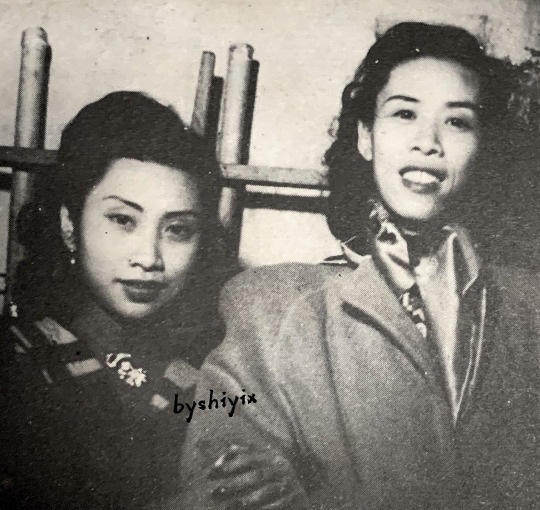
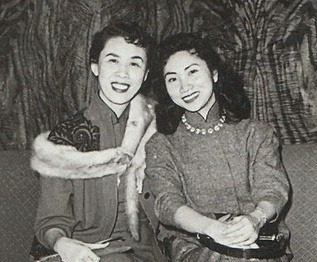
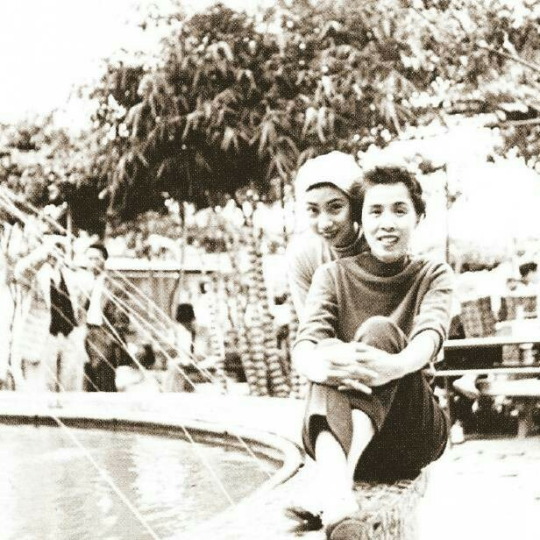

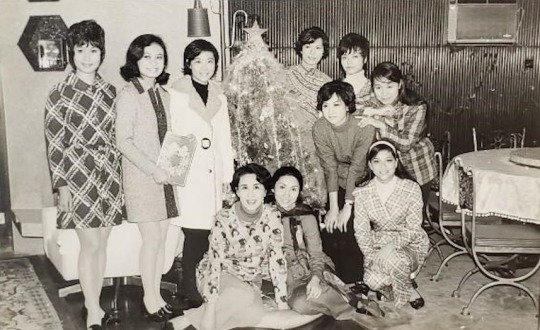

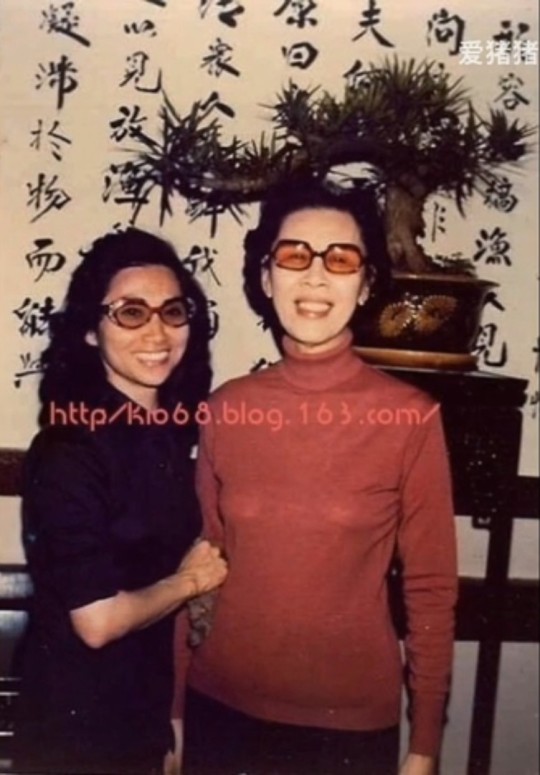
Female Queer Icons of Hong Kong // Yam Kim Fai (任劍輝) and Pak Suet Sin (白雪仙)
Photo 1: Promotional photo for 1955 contemporary movie The Model and the Car (玉女香車) (no video available) (Source: LCSD Museum Collection Search Portal)
Photo 4: Photo from Sin Fung Ming Opera Troupe's 1958 trip
Photo 5: Photo from a 1962 newspaper feature on Yam, Pak, and others at their (?) summer villa in Central, Hong Kong
Photo 6: Christmas celebrations with Yam, Pak, and their protégés of the Chor Fung Ming Troupe
Far and away the most iconic duo in Cantonese opera, Yam Kim Fai (任劍輝) and Pak Suet Sin (白雪仙) – commonly referred to simply as Yam-Pak (任白) – were famed for their partnership both on and off the stage… Click below to learn more!
Edit on 28/07/2023: Updated to link to a photo of the entrance to the Hong Kong Heritage Museum’s Pop Culture 60+ exhibit, and to add information regarding Yam and Pak's marriage status.
Iconic? How?
Yam-Pak are the face of Cantonese opera; you can't talk about the latter without mentioning the former. It's to the point where a gigantic picture of them graces the entrance to the Hong Kong Heritage Museum’s permanent exhibition on Hong Kong pop culture’s evolution across the past 60 years (“Hong Kong Pop 60+”) - they are the first thing you see upon entering!
Best known as the originators - with Yam playing the male leads and Pak the female leads - of five masterpieces of Cantonese opera, namely:
1. Princess Cheung Ping (帝女花) 2. The Legend of the Purple Hairpin (紫釵記) 3. The Dream Tryst in the Peony Pavilion (牡丹亭驚夢) 4. The Reincarnation of Lady Plum Blossom (再世紅梅記) 5. Butterfly and Red Pear Blossom (蝶影紅梨記) (Note: Princess Cheung Ping, Purple Hairpin, and Butterfly and Red Pear Blossom were made into abridged movie versions, with the Sin Fung Ming troupe members reprising their roles from the theatre productions. Also, the "Fragrant Sacrifice" (香夭) duet from Princess Cheung Ping (movie clip) is one of - if not the most - famous songs in Cantonese opera.)
Yam and Pak were the leading pair and co-founders of the legendary Sin Fung Ming Opera Troupe (仙鳳鳴劇團; 1956-1961), which is widely held to have pushed Cantonese opera forward as an artform due to Pak and scriptwriter Tong Tik Sang’s (唐滌生) emphasis on poetic libretti and adapting source material from Chinese literature and history. (Note: it has been common practice since the 1930's for Cantonese opera troupes to be founded by key actor(s).)
They were also very active in the Hong Kong film industry in the 1950's, being paired in over 40 movies together across roughly 8 years. One of those – the aforementioned Butterfly and Red Pear Blossom (蝶影紅梨記) – is the sole Cantonese opera movie on the Hong Kong Film Archive’s 100-Must See Hong Kong Movies list (IMDB list / archived version of the official PDF). It's a well-deserved inclusion - check out this beautifully-shot dance scene.
Even their post-retirement activities had a significant effect on the industry! In the early 1960’s, they held auditions for prospective students and provided - for free - systematic, hands-on training to those who passed; Yam and Pak even hired other veterans to teach skills they personally were not as familiar with. Prior to this, apprentices were expected to learn primarily from observing their masters, and to pay handsomely for the privilege. Yam-Pak’s methods proved exceedingly effective: the Chor Fung Ming Opera Troupe (雛鳳鳴劇團; 1963-1992) starring their apprentices reigned supreme in the 1970’s-1980’s. Following this success, Cantonese opera institutes - most notably the major 1900s-era guild, the Chinese Artists Association of Hong Kong (八和會館) - started to offer systematic coaching to young hopefuls in the 1980's.
Okay, so why are they queer icons specifically?
The lazy answer is that they're queer icons because nearly all of Yam's roles were male, so Gender is involved by default, and since most hit Cantonese operas of the time were romances, that means you get to see two female actors performing being in love onscreen (and also on stage, but there aren't any video recordings from back then). So far, so Takarazuka Revue.
Female actors playing male roles in Cantonese opera To give some context, each Cantonese opera performer specialises in one of four major role-types, and Yam was a sung (生) - i.e. an actor specialised in playing standard male roles. Female sung were fairly common in the 1910's-1930's due to women being banned from performing with men during that period, but when the ban lifted in the mid-1930's, many troupes shifted towards cis-casting. Yam was pretty much the only one whose popularity survived the transition. Just take a look at the huge number of Cantonese opera movies produced during the 1950’s-1960’s – you’ll be hard-pressed to find a female sung other than Yam, let alone one with top billing. Happily, thanks to Yam's immense popularity, her profilic film career (over 300 movies!), and the prominence of Sin Fung Ming works in the Cantonese opera canon, there has been a resurgence in female sung which endures to this day. Two noteworthy examples are Yam's protégé Sabrina Lee/ Loong Kim Sang (龍劍笙) - a star in her own right - and Joyce Koi/ Koi Ming Fai (蓋鳴暉), one of the biggest names still active in the industry. (Note: perhaps due to cinema being more "realistic" in nature, Yam's early movies often involved her playing female characters cross-dressing as men, including in some Cantonese opera movies. However, she received increasingly more male roles as her fame grew, and from the mid-1950's onwards she was playing male characters onscreen nearly exclusively-- even in non-Cantonese opera movies! See Photo 1 above.)
What sets Yam and Pak apart is that they were particularly known for their chemistry. Long before Sin Fung Ming's formation in 1956, the advertising copy for their first Cantonese opera movie together - Frolicking with a Pretty Maid in the Wineshop (酒樓戲鳳, 1952) - declared "Only this movie has Yam-Pak flirting on the silver screen" (source - 華僑日報 1952/05/23-26). And indeed, they were popular for their flirtatious duets: their Cantonese opera works invariably contained at least one, and such scenes made it into some of non-Cantonese opera (i.e. "contemporary") movies too. In fact, there are not one but two contemporary movies where Yam and Pak's characters are not paired up and yet still sing a duet together in such a way that their significant other(s) become convinced that the two are in romantically interested in each other - see 1952's Lovesick (為情顛倒) and 1956's The Happy Hall (滿堂吉慶) - a weirdly specific situation which doesn't crop up in the other, non-Yam-Pak movies I have seen.
Speaking of contemporary movies, let's talk about a certain plotline that keeps cropping up in works featuring the both of them and where Yam plays a woman! Six of the eleven movies which fit that criteria involve Yam's character cross-dressing as a man (a common characteristic across Yam's handful of female roles), and Pak's character falling for her. Nothing ever comes of it, of course, but, um. It was certainly a trend. Actually, even their very first movie together - 1951's Lucky Strike (福至心靈) - falls into this category.
Such storylines, and the emphasis on their chemistry, are particularly interesting given that both Yam and Pak remained ostensibly unmarried throughout. This was unusual for female performers of their stature, who tended to wed in their twenties, often to fellow-actors or wealthy men (e.g. Hung Sin Nui/紅線女, Fong Yim Fun/芳艷芬, and Tang Pik Wan/鄧碧雲)... In contrast, by the time Yam-Pak retired from the stage in 1961, they were both over 30 years old and without husbands.
Also, did I mention they were popularly believed to be living together? There doesn't seem to be any conclusive evidence either way... although it's a little strange that separate newspaper pictorials depicting "Yam at home" and "Pak at home" seem to be of the same location... however what is conclusive is that they did spent a lot of time together offstage. Pak has talked about how when they had no guests over, Yam would watch TV by herself while Pak was in the living room (source - p93), and protégé Mandy Fung/ Mui Suet Sze (梅雪詩) has said that Pak would sometimes cook for Yam at home (source - 03:53~). They would also celebrate birthdays, New Year's, and Christmas together (see Photo 6 for an example of the latter).
Shortly after Yam's passing in 1989, Pak set up the Yam Kim Fai and Pak Suet Sin Charitable Foundation (任白慈善基金) to support the arts and provide welfare for the elderly. In 1996, Pak made a large donation to Hong Kong University, resulting in one of the buildings being renamed Yam Pak Building (任白樓) in thanks (source).
Thanks for reading! Please feel free to DM me or send an ask if you have any questions, or are just interested in learning more.
If you made it here, have this bonus piece of trivia - Yam and Pak were also well-acquainted with Hong Kong's preeminent queer icon, Leslie Cheung (張國榮), who was a massive fan of theirs. Sadly there don't seem to be any pictures of them before Yam's passing, but here's one of Pak (centre) having afternoon tea with Cheung (left) and his long-term romantic partner Daffy Tong (唐鶴德) (right) at the Cova cafe in the Pacific Place shopping mall.
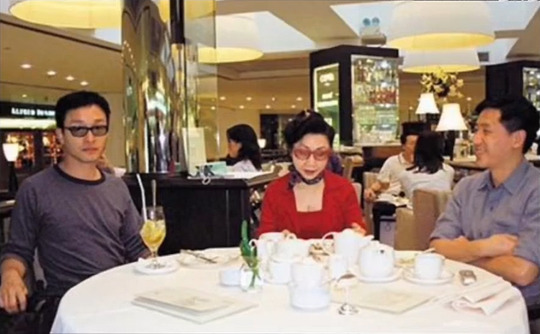
#wlw recommendations#sapphic#lgbtq#asian lgbtq#hong kong#theatre#cantonese opera#chinese opera#yam kim fai#leslie cheung#pak suet sin#yampak#yambak#pak sheut sin#bak sheut sin#hong kong queer icons#not me hastily adding tags because i keep forgetting certain ones
214 notes
·
View notes
Text
Ghost Story: a new musical is up on YouTube!
Two love stories between Chinese American and Polish American men haunt the same Montana ranch house — one century apart. As past and present intertwine, the lovers confront long-held fears in their quest to determine if they love one another for the right reasons.
youtube
GHOST STORY is a new musical exploring queer interethnic intimacies between working-class immigrants in the early Mountain West, as well as the complicated racial past of modern gay relationships. Through a story about love, culture, and identity, the show asks: In making meaning from the overwhelming tragedies of queer history, how do we balance seeking truth and beauty?
This presentation includes mature language and some mature themes. Stream our live cast album here on Spotify (and look up Ghost Story Melliot on other streaming services to find it!)
#ghost story musical#melliot#musical theater#musical theatre#new musical#musicals#queer history#lgbtq#trans#transmasc#gay#theater#theatre#aapi#chinese american#polish american#Youtube
40 notes
·
View notes